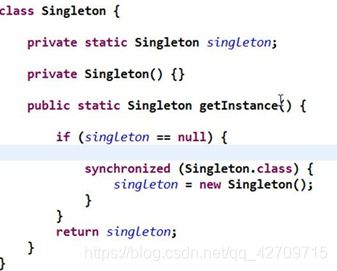单例模式(由浅到深学习设计模式)
单例模式
文章目录
- 单例模式
-
-
-
- 概述
- 应用场景(何时使用)
- 八种方式(饿汉x2,懒汉x3,其他x3)
-
- 1、饿汉模式
-
- 1)静态常量写法
- 2)静态代码块
- 2、懒汉模式
-
- 1)正常写法
- 2)同步方法
- 3)同步代码块(因为和同步代码大同小异,所以只放图,均不推荐使用)
- 3、其他
-
- 1)双重检查
- 2)静态内部类
- 3)枚举
- 总结
-
-
-
概述
1、单例模式保证了系统内存中该类只存在一个对象,节省了系统内存资源
2、当想实例化一个单例类的时候,必须要记住使用相应的获取对象的方法,而不是使用new
-
应用场景(何时使用)
1、需要频繁的进行创建和销毁的对象、创建对象时耗时过多或耗费资源过多(即:重量级对象)
2、经常用到的对象、工具类对象、频繁访问数据库或文件的对象(比如数据源、session 工厂等)
-
八种方式(饿汉x2,懒汉x3,其他x3)
1、饿汉模式
1)静态常量写法
步骤如下:
1) 构造器私有化 (防止 new )
2) 类的内部创建对象
3) 向外暴露一个静态的公共方法。getInstance
4) 代码实现
/**
* @author 漆剑
* @date 2021-03-27
* @description
*/
public class SingletonTest01 {
public static void main(String[] args) {
singleton instance = singleton.getInstance();
singleton singleton2 = singleton.getInstance();
System.out.println(instance.equals(singleton2));
}
}
class singleton{
private singleton() {
}
private final static singleton instance = new singleton();
public static singleton getInstance(){
return instance;
}
}
优缺点说明:
1) 优点:这种写法比较简单,就是在类装载的时候就完成实例化。避免了线程同步问题。
2) 缺点:在类装载的时候就完成实例化,没有达到 Lazy Loading 的效果。如果从始至终从未使用过这个实例,
则会造成内存的浪费。
结论:这种单例模式可用,但是可能造成内存浪费
2)静态代码块
步骤如下:
1) 构造器私有化 (防止 new )
2) 用静态代码块装载对象
3) 向外暴露一个静态的公共方法。getInstance
4) 代码实现
/**
* @author 漆剑
* @date 2021-03-27
* @description
*/
public class SingletonTest02 {
public static void main(String[] args) {
//测试
Singleton instance = Singleton.getInstance();
Singleton instance2 = Singleton.getInstance();
System.out.println(instance == instance2); // true
System.out.println("instance.hashCode=" + instance.hashCode());
System.out.println("instance2.hashCode=" + instance2.hashCode());
}
}
class Singleton {
//1. 构造器私有化, 外部能new
private Singleton() {
}
//2.本类内部创建对象实例
private static Singleton instance;
static {
// 在静态代码块中,创建单例对象
instance = new Singleton();
}
//3. 提供一个公有的静态方法,返回实例对象
public static Singleton getInstance() {
return instance;
}
}
优缺点说明:
这种方式和上面的方式其实类似,只不过将类实例化的过程放在了静态代码块中,也是在类装载的时候,就执行静态
代码块中的代码,初始化类的实例。优缺点和上面是一样的。
结论:这种单例模式可用,但是可能造成内存浪费
2、懒汉模式
1)正常写法
步骤如下:
1) 构造器私有化 (防止 new )
2) 向外暴露一个静态的公共方法。当使用到该方法时,才去创建 instance
3) 代码实现
/**
* @author 漆剑
* @date 2021-03-27
* @description
*/
public class SingletonTest03 {
public static void main(String[] args) {
singleton instance = singleton.getInstance();
}
}
class singleton{
private static singleton instance;
private singleton() {
}
public static singleton getInstance(){
if (instance == null){
instance = new singleton();
}
return instance;
}
}
优缺点说明:
1) 起到了 Lazy Loading 的效果,但是只能在单线程下使用。
2) 如果在多线程下,一个线程进入了 if (singleton == null)判断语句块,还未来得及往下执行,另一个线程
也通过了这个判断语句,这时便会产生多个实例。所以在多线程环境下不可使用这种方式
结论:在实际开发中,不要使用这种方式,因为线程不安全
2)同步方法
步骤如下:
1) 构造器私有化 (防止 new )
2) 提供一个静态的公有方法,加入同步处理的代码,解决线程安全问题
3) 代码实现
/**
* @author 漆剑
* @date 2021-03-27
* @description
*/
public class SingletonTest04 {
public static void main(String[] args) {
System.out.println("懒汉式2 , 线程安全~");
Singleton instance = Singleton.getInstance();
Singleton instance2 = Singleton.getInstance();
System.out.println(instance == instance2); // true
System.out.println("instance.hashCode=" + instance.hashCode());
System.out.println("instance2.hashCode=" + instance2.hashCode());
}
}
// 懒汉式(线程安全,同步方法)
class Singleton {
private static Singleton instance;
private Singleton() {
}
//提供一个静态的公有方法,加入同步处理的代码,解决线程安全问题
//即懒汉式
public static synchronized Singleton getInstance() {
if(instance == null) {
instance = new Singleton();
}
return instance;
}
}
优缺点说明:
1) 解决了线程安全问题
2) 效率太低了,每个线程在想获得类的实例时候,执行 getInstance()方法都要进行同步。而其实这个方法只执
行一次实例化代码就够了,后面的想获得该类实例,直接 return 就行了。方法进行同步效率太低
结论:在实际开发中,不推荐使用这种方式
3)同步代码块(因为和同步代码大同小异,所以只放图,均不推荐使用)
步骤如下:
1) 构造器私有化 (防止 new )
2) 提供一个静态的公有方法,且把同步放在代码块上
3) 代码实现
优缺点说明:
和同步方法大同小异
结论:在实际开发中,不推荐使用这种方式
3、其他
1)双重检查
步骤如下:
1) 构造器私有化 (防止 new ),并在变量前加上volatile
2) 提供一个静态的公有方法,加入双重检查代码(解决线程安全问题, 同时解决懒加载问题)
3) 代码实现
/**
* @author 漆剑
* @date 2021-03-27
* @description
*/
public class SingletonTest06 {
public static void main(String[] args) {
System.out.println("双重检查");
Singleton instance = Singleton.getInstance();
Singleton instance2 = Singleton.getInstance();
System.out.println(instance == instance2); // true
System.out.println("instance.hashCode=" + instance.hashCode());
System.out.println("instance2.hashCode=" + instance2.hashCode());
}
}
// 懒汉式(线程安全,同步方法)
class Singleton {
private static volatile Singleton instance;
private Singleton() {
}
//提供一个静态的公有方法,加入双重检查代码,解决线程安全问题, 同时解决懒加载问题
//同时保证了效率, 推荐使用
public static synchronized Singleton getInstance() {
if(instance == null) {
synchronized (Singleton.class) {
if(instance == null) {
instance = new Singleton();
}
}
}
return instance;
}
}
优缺点说明:
1) Double-Check 概念是多线程开发中常使用到的,如代码中所示,我们进行了两次 if (singleton == null)
检查,这样就可以保证线程安全了。
2) 这样,实例化代码只用执行一次,后面再次访问时,判断 if (singleton == null),直接 return 实例化对
象,也避免的反复进行方法同步.
3) 线程安全;延迟加载;效率较高
结论:在实际开发中,推荐使用这种单例设计模式。但是写法过于繁琐,要有一定的代码基础!
2)静态内部类
步骤如下:
1) 构造器私有化 (防止 new )
2) 写一个静态内部类,该类中有一个静态属性 Singleton
3) 提供一个静态的公有方法,直接返回SingletonInstance.INSTANCE
4) 代码实现
/**
* @author 漆剑
* @date 2021-03-27
* @description
*/
public class SingletonTest07 {
public static void main(String[] args) {
System.out.println("使用静态内部类完成单例模式");
Singleton instance = Singleton.getInstance();
Singleton instance2 = Singleton.getInstance();
System.out.println(instance == instance2); // true
System.out.println("instance.hashCode=" + instance.hashCode());
System.out.println("instance2.hashCode=" + instance2.hashCode());
}
}
// 静态内部类完成, 推荐使用
class Singleton {
//构造器私有化
private Singleton() {
}
//写一个静态内部类,该类中有一个静态属性 Singleton
private static class SingletonInstance {
private static final Singleton INSTANCE = new Singleton();
}
//提供一个静态的公有方法,直接返回SingletonInstance.INSTANCE
public static synchronized Singleton getInstance() {
return SingletonInstance.INSTANCE;
}
}
优缺点说明:
1) 静态内部类方式在 Singleton 类被装载时并不会立即实例化,而是在需要实例化时,调用 getInstance 方法
,才会装载 SingletonInstance 类,从而完成 Singleton 的实例化。
2) 类的静态属性只会在第一次加载类的时候初始化,所以在这里,JVM 帮助我们保证了线程的安全性,在类进行初
始化时,别的线程是无法进入的。
3) 避免了线程不安全,利用静态内部类特点实现延迟加载,效率高
结论:在实际开发中,推荐使用这种单例设计模式
3)枚举
步骤如下:
1) 建立一个枚举类,设置其属性
2) 使用枚举来创建对象
3) 代码实现
/**
* @author 漆剑
* @date 2021-03-27
* @description
*/
public class SingletonTest08 {
public static void main(String[] args) {
Singleton instance = Singleton.INSTANCE;
Singleton instance2 = Singleton.INSTANCE;
System.out.println(instance == instance2);
System.out.println(instance.hashCode());
System.out.println(instance2.hashCode());
instance.sayOK();
}
}
//使用枚举,可以实现单例, 推荐
enum Singleton {
INSTANCE; //属性
public void sayOK() {
System.out.println("ok~");
}
}
优缺点说明:
1) 这借助 JDK1.5 中添加的枚举来实现单例模式。不仅能避免多线程同步问题,而且还能防止反序列化重新创建
新的对象。
2) 这种方式是 Effective Java 作者 Josh Bloch 提倡的方式
结论:在实际开发中,推荐使用这种单例设计模式
-
总结
以下四种方式可用:
- 明确要用到的饿汉式
- 双重检查
- 静态内部类
- 枚举方法
由于水平有限,本博客难免有不足,恳请各位大佬不吝赐教!
